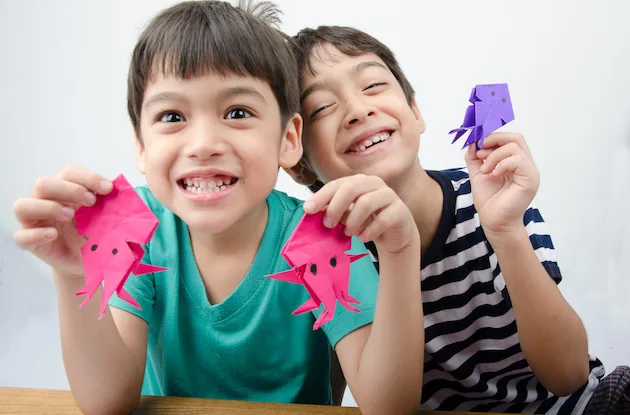Are toys made with polyvinyl chloride (PVC) safe? No doubt many parents have heard the claim that they are not — that toxic substances can leach out of rubber duckies and other playthings as children chew and suck on them. Still, government agencies have held steadfast that chemicals released from PVC in toys aren’t significant enough to bring harm to children. The debate re-ignited earlier this year with the Consumer Safety Product Commission’s (CPSC) decision to r eject a petition requesting a ban on PVC in children’s products; the recent release of a survey on PVC use by toy companies has also sparked controversy.
PVC, commonly known as vinyl, has been used for over 50 years, and its use is not restricted to toys. It is also found in many everyday items, including pipes, siding, caulk, furniture, adhesives, nail polish, hospital supplies, and even food packaging. PVC itself is not the primary object of concern. It is the chemicals with which it is mixed that have raised red flags. PVC alone is very hard and brittle, and degrades fairly easily. It must be combined with other substances to make it useful. For example, lead and cadmium can stabilize PVC, and a group of chemicals called phthalates (pronounced THAL-ates) can plasticize it, causing it to be softer and more flexible without losing durability. The most common phthalate found in PVC is diisononyl phthalate (DINP), but others are also in use. Such additives (especially phthalates, which are not tightly bound to the PVC polymer) could theoretically leak out of a product over time, and put a user at risk, depending on the amount of exposure. PVC opponents cite certain animal studies, which indicate that extremely high levels of some phthalates can cause liver, kidney, and reproductive damage. They also point to the well-known dangers of ingesting high doses of lead or cadmium.
Beginnings of the toxic toy scare In 1996, a number of children were poisoned by large quantities of lead released from vinyl miniblinds; the CPSC promptly issued warnings about the problem. Soon after, Greenpeace, the non-profit pro-environment organization, examined other vinyl products that children were likely to encounter. They found that many playthings contain potentially toxic substances, such as phthalates and lead. Since then, the group has been on a mission to inform parents. But even before it turned the spotlight on toys, Greenpeace was a staunch opponent of PVC in any capacity, stressing that its production, use and disposal result in the release of hazardous chemicals into the environment. It is important to note that there was — and still is — much debate about whether any chemicals are released from PVC toys in quantities sufficient to do harm. Nevertheless, many have assumed the worst and have started to take action. The European Union and Japan have placed restrictions on phthalate use in toys. In addition, in 1998, the CPSC recommended a voluntary withdrawal of phthalate-containing teethers, rattles, and pacifiers from the market.
CPSC denies petition to ban PVC Keen to see a tougher stance in the United States, 12 organizations, including Greenpeace, submitted a petition to the CPSC in 1998. They asked for a ban on PVC in all products intended for children 5 years of age and under, and for the issuance of a national health advisory about PVC toys. However, in February, the CPSC voted unanimously to deny their request. The CPSC concluded that PVC toys are completely safe, that the levels of phthalates, lead or other chemicals that might possibly be ingested by children during normal play are far below the acceptable daily intake (ADI) level for these substances. The CPSC based its conclusion primarily on three pieces of information: The first was an independent scientific panel’s estimate that, based on the level of DINP released by PVC toys, children might be at risk only if they mouthed toys for more than 75 minutes per day. The second was a behavioral study showing that children, on average, actually mouth toys for only 1.9 minutes per day. The third was a 1997 finding that lead and cadmium were not released from PVC toys in appreciable amounts. All of the relevant reports can be found on the CPSC website (www.cpsc.gov).
CPSC spokesperson Ken Giles summarizes the commission’s decision: “The dose makes the poison. The mere presence of a substance does not indicate risk.” Giles also addresses the impression by some PVC opponents that other countries are taking a tougher approach to the issue than the United States. “They are concerned any time there is chronic exposure, even if there is no proven risk.” The CPSC’s conclusion about lead and cadmium begs a question: Why would lead be released from vinyl miniblinds, but not from vinyl toys? According to Giles, the answer lies in the type of normal product use. “In the miniblinds, exposure to ultraviolet light for many hours every day can cause the PVC to deteriorate, and allow the lead to come to the surface.” He says this should not be a concern with vinyl toys. The chemical and toy industries have long maintained that toys that contain PVC are not toxic, and the CPSC decision bolsters their stance. The Juvenile Products Manufacturers Association (JPMA) supports the commission’s ruling. “The CPSC decision assures parents that PVC products do not pose a hazard to children and confirms what we have believed all along,” says JPMA president Robert Waller. “These durable hygienic products have been safely used for decades. Parents can be assured they are safe.” Jennifer Szwalek, JPMA vice president of communications, elaborates: “We hope groups that had mistakenly championed this cause will focus resources on reducing real world hazards to newborns and infants. Our goal has always been to reduce demonstrable risks to newborns and infants from SIDS, childhood diseases and accidents.” Rick Hind, legislative director of the Greenpeace Toxics Campaign, strongly disagrees that PVC toys are harmless. He insists the CPSC’s average toy-mouthing time is far too low. Furthermore, he says the amount of contact children have with toxins is consistently miscalculated. “Cumulative exposure of children [to phthalates and other PVC additives] is much higher than estimated with just toys,” Hind says. “Children touch and lick everything in the home.” Hind also says the risk from lead, cadmium and other chemicals found in PVC has been misjudged by the CPSC.
Toy information Other than the CPSC report, much of the available information about the safety of PVC and phthalates comes from three major sources — the toy industry, the chemical industry, and environmental watchdog organizations like Greenpeace. With these different agendas and viewpoints, parents are still left to decide whether or not they should allow their children to play with vinyl toys.
If you do decide to keep your children away from PVC or phthalate-containing toys, how can you identify them? There are no obvious signs, so some research is necessary. Greenpeace provides a good place to start. In 2000, the group issued a ‘report card’ on toy manufacturers. It surveyed each company, asking for a truthful assessment of both PVC and phthalate use in their products. In February, Greenpeace released an update to the survey. Interested parents can find details and company contact information at its website (www.greenpeaceusa.org). According to the report card, several toy manufacturers appear strongly committed to phasing out PVC entirely, meriting an A rating: Brio, Chicco, Evenflo, Gerber, International Playthings (Primetime and Early Start), Lamaze Infant development, Lego Systems, Sassy, and Tiny Love. Two companies, Discovery Toys and Manhattan Baby, will phase out PVC in a few products (B rating). Three companies — First Years, Little Tykes and Mattel/Tyco/Fisher Price — plan to eliminate phthalates in toys intended for children under 3 (C rating). A couple of manufacturers, Munchkin Inc. and Shelcore, intend to remove phthalates only from toys intended for the mouth (D rating). Finally, many that were given D or F grades by Greenpeace in 2000, did not respond to repeated 2003 survey requests: Disney, Hasbro/Galoob/Playschool, Kids II, Safety First, and Warner Bros. According to Hind, Greenpeace will continue to pressure toy manufacturers to prevent backslides because of the CPSC decision.
Given that alternatives do exist, why do toy companies continue to use a controversial substance at all? Lisa Marie Bongiovanni, a spokesperson for Mattel/Tyco/Fisher Price, says: “PVC has been studied for over 50 years, and any new materials need to be as safe or safer than current products. We are not at the point where we think that any [of the alternative plastics] are as safe in several regards. Our greatest concern is the safety of children. We use only materials that have been rigorously tested.” She cites resistance to microorganisms and durability (that a toy will not break under heavy use to produce sharp edges or small parts) as two of the main considerations.
Toxins, toxins everywhere? Many parents worry about their family’s exposure to toxins, especially in New York City. Numerous groups claim that there are hazardous substances all around us. There is even a scary-sounding name for a person’s internal concentration of contaminants — the “body burden”. Earlier this year, the Centers for Disease Control and Prevention released its Second National Report on Human Exposure to Environmental Chemicals (http://www.cdc.gov/exposurereport/), which assesses just how exposed the general population is to 116 chemicals. The Centers are quick to stress that just because a chemical is present does not necessarily mean that it poses a threat. In addition, the results of another similar study are available from the Environmental Working Group (http://www.bodyburden.org/). On this site, it’s possible to find out what chemicals, including phthalates, might make up your own “body burden” (http://www.ewg.org/reports/bodyburden/usertest/). Parents may be wondering how much of all this toxic talk is hype and how much is really cause for concern. Clearly, the world does not agree on the answer. In the end, each family must make their own decisions about what to eat, what to drink, where to live — and what their children should play with.
Product Registration Cards for Children’s Products? CPSC says no, but legislation introduced In a move that seemed to signal an unwelcome defeat to consumers, the U.S. Consumer Product Safety Commission (CPSC) voted 2-1 last month to deny a petition to require product registration cards (PRC) for children’s products. But in light of the CPSC move, legislators reintroduced a bill several days later that, if passed, would require manufacturers of certain consumer products to establish and maintain a system for providing notification of recalls of such products directly to the consumers who buy them. The current recall notification system relies upon the media to convey the news of product recalls to the public. Return rates for recalled products are relatively low — only 16 percent in 1997, the most recent year for which data is available. Many of these recalls involve children’s products. In 2002 alone, the CPSC issued recalls for 84 children’s products, including more than 11 million actual goods. Recalls often occur because of choking, strangulation, suffocation, burns or serious fall hazards. The petition, submitted to the CPSC by the Consumer Federation of America, requested that the Commission require manufacturers, distributors, retailers or importers of children’s products to include a product registration card with their products. Such a requirement, consumer advocates urged, would help decrease the number of injuries and deaths caused by recalled products that are not returned. The three-member Commission rejected the petition despite the fact that it is has been involved in ongoing comprehensive research to improve recall effectiveness; a recall effectiveness roundtable that will include CPSC staff, consumer advocates, members of industry, marketing professionals and social scientists will be convened next month. Commission members cited several reasons for their decision, including the lack of legal authority the CPSC has to enforce a PRC database, the likelihood that a rule requiring a PRC for such a broad range of products would violate the equal protection clause of the Constitution, and the costs associated with enforcing such a vast system. CPSC chairman Hal Stratton, who moved to deny the petition, said of his vote: “If interpreted broadly, such a rule would encompass a wide variety of products, from giveaway toys from fast food restaurants to children’s clothing, bedding, art supplies, and toys, which are generally manufactured for children. It might also encompass products that may be used by both children and adults, such as televisions, computers, radios, furniture, kitchen products, and practically any other product.” Stratton went on to say that the many types of products covered by the petition have significantly different product live — some lasting for years, others for only a single use, and others passed from person to person so that the original owner no longer knows who possesses the product. “A one-size-fits-all rule as contemplated by the petition to cover such a broad scope of products is not practicable,” the chairman noted, calling for a more targeted approach to products to be affected to increase product recall effectiveness. The newly introduced federal legislation, known as the “Product Safety Notification and Recall Effectiveness Act”, would give the Commission the authority to establish and maintain such a product safety card system for providing recall notification. The CPSC is currently conducting its own comprehensive study — which includes a product registration system for certain types of products — that evaluates consumer behavior and explores ideas for improving the recall process; its completion is expected by fall 2004.





















